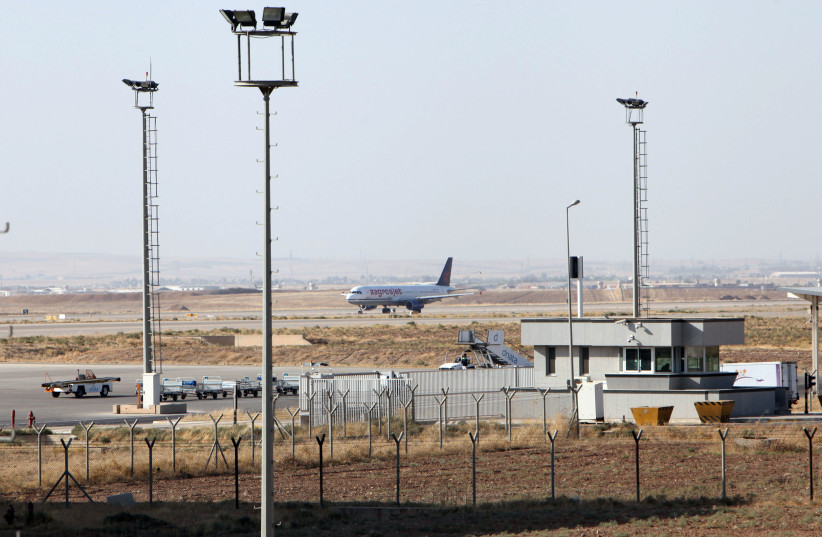Iran is suspected of launching a missile attack on Erbil in Kurdistan early Sunday morning that struck near the US Consulate under construction there.
Erbil was attacked by 12 missiles at 1:30 a.m., the Kurdistan Regional Government’s Counter-Terrorism Service said. “The attacks resulted in no casualties, and the missiles were launched from outside of Kurdistan and Iraq,” it said.
This is a large attack and was likely carried out from Iran. The missiles struck near a new large US Consulate being built in Erbil. In fact, the consulate is not in the center of the city, and it’s clear that coordinates for the consulate would have to be put into precision strikes of ballistic-style missiles. This is a tactic Iran has deployed before.
What we know in the wake of the attack is that Kurdistan regional authorities said there were no civilian casualties. Kurdistan Region Prime Minister Masrour Barzani condemned the attack.
This is an Iranian attack on the US in Iraq.

The Kurdistan Region is an autonomous area. Since 2019, the US has positioned more forces in the region after Iran attacked US facilities in other parts of Iraq.
After the US killed Islamic Revolutionary Guard Corps commander Qasem Soleimani in Baghdad in 2020, more US forces were concentrated in the Kurdistan Region. The US has forces at al-Asad air base and in Baghdad. However, other US facilities, such as in Taji, were closed in 2020.
This pattern of US repositioning in Iraq coincided with US-Iran tensions in 2019-2020. Iran began tasking its Iraqi-based militias, including Kataib Hezbollah, to target Erbil with missiles.
The US has a facility at Erbil International Airport, and in September 2020, 122-mm. Grad rockets were fired from Nineveh Plains at the airport perimeter. In February 2021, another round of 107-mm. rockets, thought to be at least 14, were fired at Erbil. These are short-range rockets.
Iran has also used ballistic missiles against the Kurdistan Region. In September 2018, Iran used Fateh-110 ballistic missiles to target Kurdish dissidents in Koya. The precision strike included Iran using drones to collect intelligence and battle-damage assessment.
It is now clear that this 2018 attack foreshadowed Sunday’s attack. It means Iran was learning from previous attacks on Erbil and was weighing what type of munitions to use.
Iran has also sent drones and fired missiles into Iraq, Syria and Lebanon to threaten the US and Israel. Last year, Iran used drones to target the Tanf US military base in Syria. Iran used drones against Israel in February 2018, in March 2021 and in May 2021, launched them from Syria, Iraq and Iran.
Iran is becoming more brazen. Last April, Iran used drones to target a hangar at Erbil’s airport. The hangar was used by the CIA, The Washington Post reported. This was one of several drone attacks on Erbil last year.
Iran moved from 107- and 122-mm. rockets to drones to test their effectiveness. Iran uses kamikaze-style drones that operationally resemble a cruise missile or V-1 rocket.
Iran has sent the same technology to Houthis in Yemen and Hamas in Gaza. Drones were used not only in April 2021 but also in June and September 2021 and in mid-February 2022. This means the drone threat against US forces in Erbil has been growing. A US facility at Harir in northern Iraq has also been targeted.
Iran’s message appears to be that it can drive the US out of Iraq. While the Kurdistan Region is autonomous and has generally been peaceful, prosperous and safe, the Iranian message is that it can target the US wherever the US has facilities.
Reports also say that damage was done to the Kurdistan24 media building in Erbil. This means Iran may be targeting media linked to the ruling Kurdistan Democratic Party and trying to send a message to the Kurdish leadership as well.
Social-media users have said the missiles used in the March 13 attack were Fateh missiles. These are large missiles with a large warhead. Video reports also showed the missile impacts. With such large missiles and so many of them fired, the fact there are no casualties appears interesting.
Iran may have planned to hit areas without many people and after 1 a.m., when many are home. However, this could be luck as well. When Iran targeted the Assad base in January 2020, there were no casualties. But subsequent reports noted how close the US came to losing lives. Many US soldiers had concussions after the ballistic-missile attacks.
The attack shows the danger of Iranian missiles and also Iran’s ability to carry out precision strikes. It is likely a message to the US as the Iran deal talks appear to be failing.
With the talks failing, Iran is saying it can go back to targeting US forces as it did in 2019, and that these attacks could get worse.
The US Consulate building in Erbil is supposed to be an alternative to the US Embassy in Baghdad because of its size. It was designed to be safe and secure in the friendly Kurdish Region. However, the attacks show that Iran can easily target the US facility.
